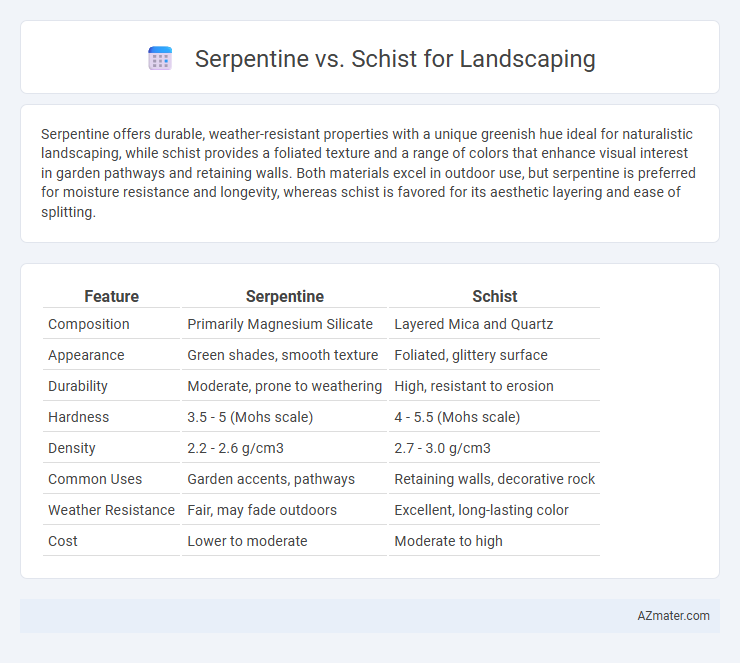Serpentine offers durable, weather-resistant properties with a unique greenish hue ideal for naturalistic landscaping, while schist provides a foliated texture and a range of colors that enhance visual interest in garden pathways and retaining walls. Both materials excel in outdoor use, but serpentine is preferred for moisture resistance and longevity, whereas schist is favored for its aesthetic layering and ease of splitting.
Table of Comparison
| Feature | Serpentine | Schist |
|---|---|---|
| Composition | Primarily Magnesium Silicate | Layered Mica and Quartz |
| Appearance | Green shades, smooth texture | Foliated, glittery surface |
| Durability | Moderate, prone to weathering | High, resistant to erosion |
| Hardness | 3.5 - 5 (Mohs scale) | 4 - 5.5 (Mohs scale) |
| Density | 2.2 - 2.6 g/cm3 | 2.7 - 3.0 g/cm3 |
| Common Uses | Garden accents, pathways | Retaining walls, decorative rock |
| Weather Resistance | Fair, may fade outdoors | Excellent, long-lasting color |
| Cost | Lower to moderate | Moderate to high |
Introduction to Serpentine and Schist
Serpentine and schist are popular metamorphic rocks commonly used in landscaping due to their unique textures and colors. Serpentine often features a greenish hue with a smooth, waxy surface, making it ideal for decorative garden stones and pathways. Schist, characterized by its foliated structure and shiny mica flakes, provides a rugged aesthetic suitable for retaining walls and garden beds.
Geological Origins of Serpentine and Schist
Serpentine originates from the alteration of ultramafic rocks such as peridotite and dunite, forming through the hydration and metamorphic transformation of mantle-derived materials, resulting in a distinctive greenish, often slick texture ideal for unique landscaping aesthetics. Schist develops from regional metamorphism of sedimentary or igneous rocks rich in mica, characterized by its foliated, flaky structure that provides a textured, layered appearance appealing in garden and pathway designs. Understanding the geological history of serpentine and schist informs their durability, mineral composition, and suitability for various landscaping applications.
Physical Properties and Appearance
Serpentine features a smooth, waxy texture with a range of green shades, often exhibiting mottled patterns that bring a natural, calming aesthetic to landscaping. Schist presents a coarse, foliated texture with pronounced mineral grains and a shimmering appearance due to its mica content, adding visual interest through its layered structure. The physical durability of schist generally surpasses serpentine, making schist more suitable for high-traffic areas, while serpentine's unique coloration enhances softer landscape designs.
Durability and Weather Resistance
Serpentine offers moderate durability with good resistance to weathering, making it suitable for landscaping in areas with mild to moderate climate variations. Schist provides higher durability and excellent weather resistance due to its foliated texture, allowing it to withstand freeze-thaw cycles and heavy rainfall better. For landscaping projects requiring long-lasting stone with superior weather resilience, schist is generally the preferred choice over serpentine.
Color Variations and Aesthetic Appeal
Serpentine offers a rich palette of deep greens, often with mottled or veined patterns that create a dynamic and natural appeal, ideal for lush, earthy landscapes. Schist displays a broader range of colors, including silver, gray, blue, and bronze hues, with a distinctive flaky texture that adds rugged elegance and visual interest to garden beds and pathways. Both stones enhance aesthetic appeal, but serpentine's green tones complement verdant environments, while schist provides versatile, shimmering accents suitable for modern or traditional landscape designs.
Ease of Installation and Maintenance
Serpentine offers easier installation for landscaping due to its relatively softer texture, allowing for straightforward cutting and shaping compared to the harder, more brittle schist. Maintenance of serpentine is minimal as its natural durability resists weathering and erosion, reducing the need for frequent upkeep. In contrast, schist can require more careful handling during installation to avoid fracture and may demand regular maintenance to address flaking and moss growth, especially in damp environments.
Environmental Impact and Sustainability
Serpentine and schist are both metamorphic rocks used in landscaping, but serpentine contains higher levels of magnesium and heavy metals, leading to potential soil contamination and negative effects on local ecosystems. Schist, composed mainly of mica and quartz, tends to be more environmentally neutral and promotes better soil health due to its mineral composition and weathering properties. Selecting schist over serpentine improves sustainability by reducing harmful leachates and supporting healthier plant growth in landscape designs.
Cost Comparison: Serpentine vs Schist
Serpentine typically costs between $30 and $50 per ton, making it an affordable option for landscaping projects compared to schist, which averages around $40 to $70 per ton due to its higher demand and decorative appeal. The price variation is influenced by factors such as quarry location, availability, and stone quality, with schist often costing more because of its layered texture and durability. Choosing serpentine can reduce overall landscaping expenses when budget constraints are a priority, while schist provides added aesthetic value that may justify the higher cost for premium designs.
Best Landscaping Applications for Each Stone
Serpentine is ideal for landscaping applications requiring a rich green color and smooth texture, making it perfect for garden pathways, decorative rock walls, and water features that benefit from its aesthetic appeal and resistance to weathering. Schist, with its foliated texture and complementary earth-tone hues, excels in creating retaining walls, rustic garden borders, and naturalistic rockeries where durability and a rugged appearance are desired. Choosing serpentine or schist depends on the desired visual effect and functional aspects such as erosion control and soil stability in landscaping projects.
Choosing Between Serpentine and Schist for Your Project
Serpentine offers a rich green color with smooth textures that enhance garden pathways and accent walls, while schist provides a rugged, layered appearance ideal for retaining walls and naturalistic designs. Consider serpentine for projects requiring a softer, calming aesthetic, especially in moist environments where its weather resistance is beneficial. Schist's durability and flaky structure make it suitable for areas needing strong drainage and textured surfaces in both residential and commercial landscapes.

Infographic: Serpentine vs Schist for Landscaping
 azmater.com
azmater.com